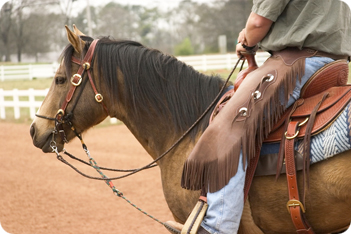
Natural Horsemanship
Horse Whispering
From: Horse Training
See Also Horse Evolution | Horse Behaviour| Horse Behaviour Characteristics

Natural horsemanship
The gentle art of working with horses through respect and understanding their natural behavioural instincts.
Basic Principles
Natural horsemanship is the training of horses using techniques based on how horses behave in the wild and using the horses own natural instincts and psychology to help train them.
By encouraging trust and understanding the trainer will be able to educate or help to re educate a horse and therefore develop a close bond with that horse. This bond would be similar to the relationship that horses would have within a herd, therefore allowing the trainer to become a trusted friend.
Techniques Used
Natural horsemanship harnesses the horses own natural behavioural instincts such as using the horses body language to allow the trainer to recognise signs such as when a horse is being threatening, anxious, aggressive or submissive. The trainer will look at head carriage, ear position, body positioning and leg activity and then act upon these signs accordingly using either a positive or negative reinforcement.
Trainer
The trainer needs to be knowledgeable of the horses natural instincts and be confident, assertive and quick to notice even the most subtle of changes to the horses behaviour and body position. When natural horsemanship is done correctly the horse will gain in confidence and security and will learn to trust the trainer.
The trainer will use their own voice and body language to not only calm a horse but also to reinforce or assert their authority and therefore gain the horses trust.
If you observe horses in the wild you will learn a great deal about horse behaviour within a herd and it is this behaviour that you, the trainer need to capture and work with not against.
Natural Horsemanship Trainers
Here are some well known and much respected trainers of natural horsemanship.
- Clinton Anderson
- "Buck" Brannaman
- Frank Bell
- Mark Rashid
- Monty Roberts
- Pat Parelli
- Ray Hunt
- Steve Jefferys
- Steve Halfpenny
Natural Horsemanship History
Horse whispering was the term given to Daniel Sullivan who rehabilitated horses in the 1800's. Sullivan used methods that were so secret and mysterious at the time that he gave the impression that he was just whispering to even the most viscous of horses to calm, reassure and train them.
Willis J Powell learnt from Sullivan and traveled around America helping to retrain many horses. Later Powell cooperated with John Soloman Rarey.
John Soloman Rarey used techniques to calm horses by proving to them that he wasn't going to hurt them even when they were at their most vulnerable. Rarey would do this by encouraging the horse to lay down and then stroke and handle the horse when it was lying on ground thus proving to them that he was not a threat. Rarey is most famously known for calming down a ferocious horse called Cruiser. Rarey was warned not to go into the stable with him but Rarey did and after three hours came out of the stable with Cruiser quietly and calmly by his side. The owners of Cruiser were so astonished that they actually gave Rarey the horse afterwards.